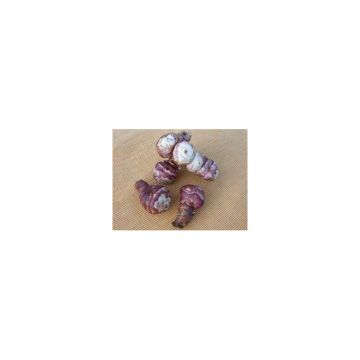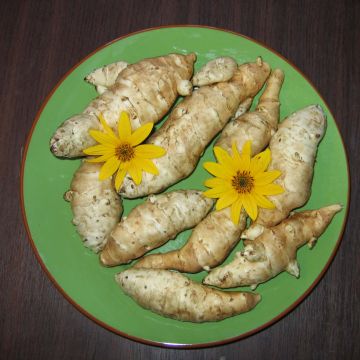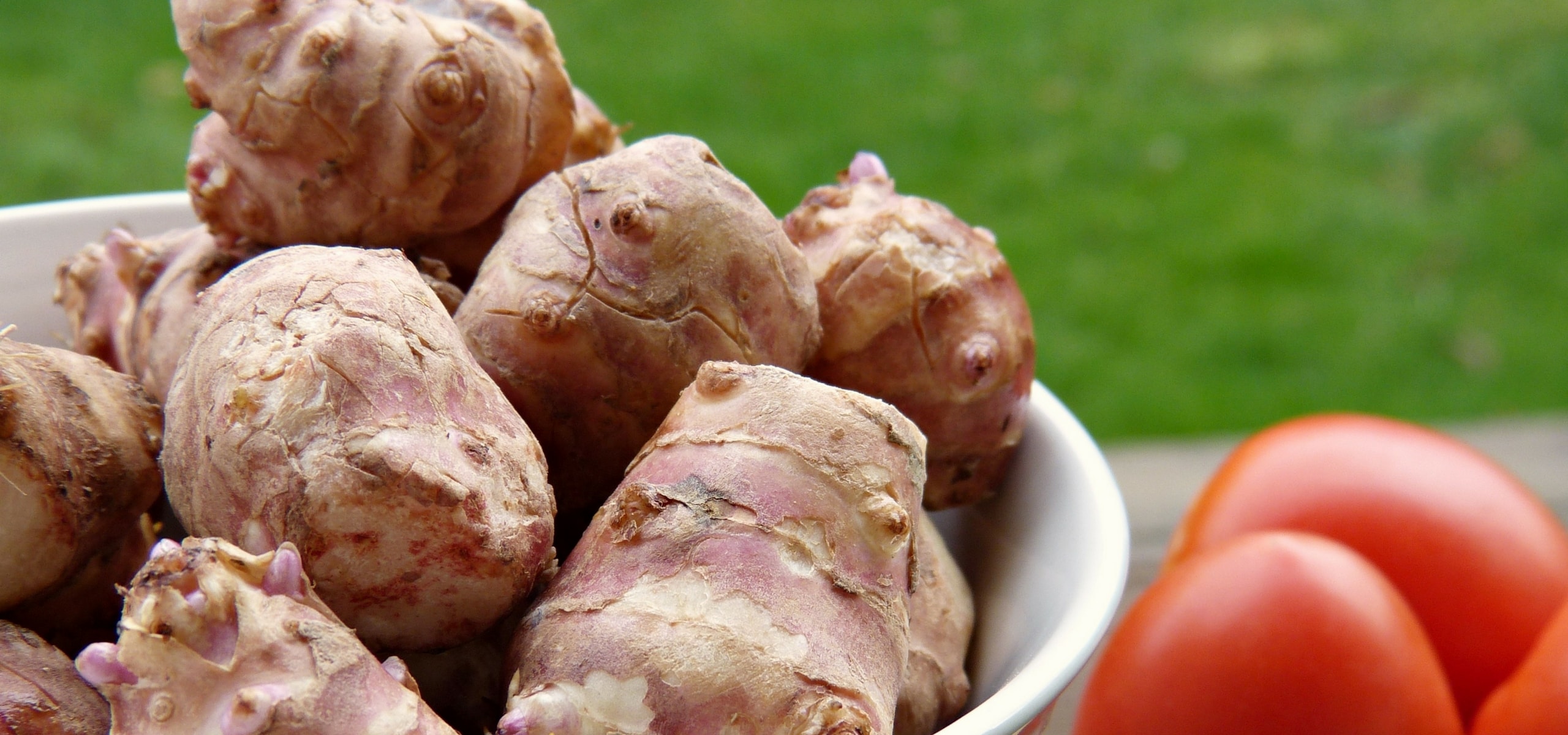
Complete guide to planting and successfully growing Jerusalem artichokes in the garden
All our tips
Contents
The Jerusalem artichoke, this ancient vegetable with tasty tubercles, is making a grand return to our gardens thanks to its particularly simple cultivation. A cousin of the sunflower with its magnificent yellow flowers, this hardy vegetable adapts to almost all soils and offers you a generous harvest for several months. Its planting requires little effort for a unique taste reward, with a delicate flavour reminiscent of artichoke that will delight the palates of the most discerning gourmets in delicious recipes. Discover our practical tips for successfully planting your Jerusalem artichokes and enjoy this vegetable that is as decorative as it is tasty!
And to learn everything about the Jerusalem artichoke and its cultivation, feel free to check our comprehensive guides: “Jerusalem artichoke: planting, harvest, cultivation” and 9 ancient vegetables to grow in the garden
: “Jerusalem artichoke: planting, harvest, cultivation”
The characteristics of this forgotten vegetable
Native to North America, the Helianthus tuberosus belongs to the aster family, like the sunflower, which it shares a tall silhouette with. This perennial plant can reach heights of 2 to 3 metres, forming lush vegetation crowned with lovely yellow flowers at the end of summer.
Its tubers, with white flesh and a subtle taste reminiscent of artichoke, have a characteristic club shape. Rich in inulin, a carbohydrate with prebiotic properties, these true underground treasures are an excellent source of potassium. Sometimes referred to as the Canadian truffle, it is distinguished by its remarkable ability to thrive year after year, even in less than favourable conditions.
Height and Development
This spectacular plant shows impressive growth in full sun as well as in partial shade. Its robust flowering stems quickly reach for the sky, peaking at the end of summer. The broad, rough leaves unfold along the stems to form a dense natural screen. One month after planting, your Jerusalem artichoke can already measure over a metre, eventually reaching between 2 and 3 metres depending on exposure.
This exceptional vigour makes it an excellent natural screen, but it requires some tips to manage its development. To contain its spread, prefer a dedicated space away from other crops, where its vigorous stems can thrive without competing with your other vegetables.
Decorative Flowers
The flowers of the Jerusalem artichoke brighten the garden with their golden petals from August to October. These flowers, resembling small suns, bloom in airy clusters at the top of the stems. Their bright yellow colour creates a striking contrast with the deep green foliage.
Measuring 8 to 10 cm in diameter, each flower features a crown of ligules surrounding a brown-orange centre. This generous flowering attracts numerous pollinators and transforms your vegetable garden into a true oasis of biodiversity. Bees and butterflies are drawn to these mini-sunflowers, adding valuable ornamental dimension to your crops.
Edible Tubers
The tubers of the Jerusalem artichoke are a true culinary treasure sought after by lovers of authentic flavours. Their white, crunchy flesh develops subtle notes of artichoke and hazelnut, particularly appreciated in soups. Irregular and knobby in shape, these nourishing roots are covered with a thin skin that ranges from rosy beige to purple depending on the variety.
Rich in fibre and inulin, these tubers offer a valuable alternative to potatoes, especially for those monitoring their blood sugar levels. Their harvest spans from October to the first frosts, allowing you to enjoy these ancient vegetables throughout the winter. Young Jerusalem artichokes, being more tender, can even be eaten raw, grated in salads.
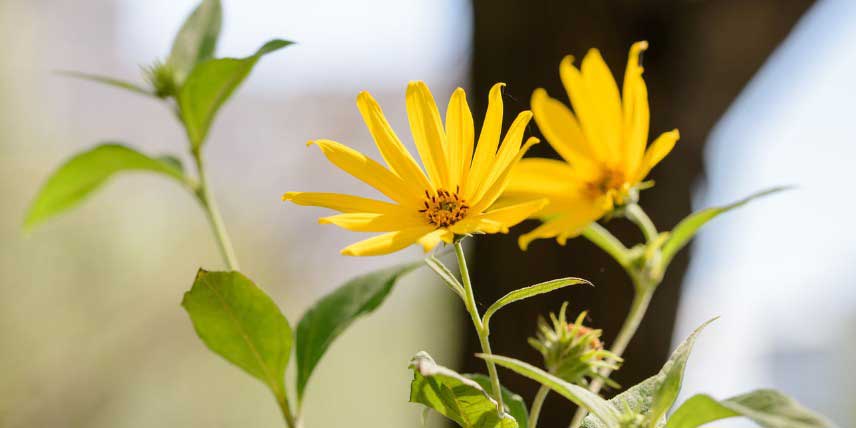
In addition to its ease of cultivation and nutritional qualities, the Jerusalem artichoke offers splendid yellow flowering!
Choosing the Right Plot for Your Vegetable Garden
The Ideal Exposure
Opt for a sunny location to achieve vigorous growth and generous flowering. Your young plant of Jerusalem artichoke will thrive fully in a light-filled spot, sheltered from prevailing winds that could weaken its tall stems. Partial shade is also suitable, with slightly lower production but still satisfactory.
An open space, at the edge of a vegetable garden or along a fence, will provide the perfect conditions for this decorative plant to spread its lush foliage without interfering with other crops. Its tall silhouette can also serve as a natural screen or hide an unsightly wall while producing delicious tubercles.
The Suitable Soil Type
With remarkable adaptability, this hardy plant thrives in almost all types of soil. It shows a natural preference for light, humus-rich soils, where its tubercles develop harmoniously. A loose, well-drained soil promotes the formation of beautiful, regular tubercles, particularly valued for their good culinary quality. Sandy or sandy-clay soils provide ideal conditions, allowing for easier harvesting and generous yields.
Even in calcareous or relatively poor soil, the Jerusalem artichoke flourishes effortlessly, demonstrating its remarkable hardiness. Only waterlogged soils should be avoided, as excess moisture can compromise the development of the precious tubercles. A sunny exposure combined with well-structured soil ensures abundant production for the following year.
Crop Rotation
Crop rotation makes perfect sense with Jerusalem artichoke, a particularly greedy plant that quickly depletes the soil. A plot hosting these tubercles requires a minimum rest period of 4 years before replanting Jerusalem artichokes. During this time, favour less demanding crops such as leafy vegetables or legumes that will naturally enrich the soil with nitrogen.
A well-thought-out cropping cycle helps maintain soil fertility while limiting the risk of diseases. After a harvest of Jerusalem artichokes, sow green manures like phacelia or mustard to regenerate the soil structure. The following spring, plant light leafy vegetables, followed the year after by legumes such as beans or peas. This reasoned succession ensures abundant harvests year after year.
Discover other Jerusalem Artichoke seeds
View all →Available in 1 sizes
Available in 2 sizes
Step-by-step planting
The Optimal Period
To succeed in your plantings, two periods are available to you throughout the seasons. Spring remains the preferred time, from March to April, when the soils warm up gently. This period allows tubercles to develop a vigorous root system before the summer heat. An interesting alternative presents itself in autumn, from September to October, particularly in regions with a mild climate.
The choice of period also depends on your region and the type of soil. In the North of France, opt for a spring planting that will give the plants the necessary time to establish themselves. In the South, autumn planting works perfectly, with tubercles benefiting from seasonal rains for optimal starting. This planting flexibility well illustrates the extraordinary adaptability of this Jerusalem artichoke.
The Distances to Respect
The proper arrangement of plants determines the success of your topinambour cultivation. A spacing of 70 cm between each tubercle is necessary for their harmonious development. The rows should also be spaced 70 to 80 cm apart, leaving enough space for the future imposing stems.
A linear planting along a fence or at the edge of the garden best values this generous spacing. This arrangement not only facilitates maintenance and harvesting but also prevents competition between the plants. In particularly rich soils, these distances can be increased up to 90 cm to support more vigorous growth.
The Planting Depth
A precise burial of the tubercles conditions the success of your cultivation. Topinambours are planted in furrows 10 to 15 cm deep, with the shoots oriented upwards to promote rapid emergence. This technique ensures optimal protection against climatic hazards while facilitating root development.
The covering of the tubercles deserves particular attention. After placing them, fill the furrows with previously loosened soil, without excessively compacting it. A slight earthing up as soon as the first shoots appear will strengthen the anchorage of the plants and stimulate tubercle formation.
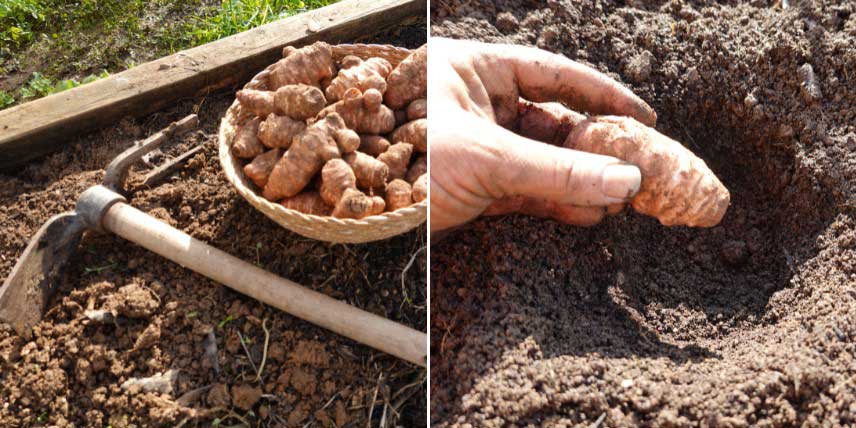
After loosening the soil, dig planting holes and place the tubercles about 10 cm deep
Seasonal Maintenance
Watering and Mulching
Moderate your watering according to the actual needs of the plant. A regular supply of water is only necessary during the first few weeks after planting, and then in case of prolonged drought. Installing a generous layer of mulch around the plants helps maintain consistent moisture and reduces the need for interventions.
Applying a layer of straw or hay 5 to 10 cm thick provides multiple benefits. In addition to preserving soil freshness, this natural mulch gradually enriches the soil as it decomposes and slows the appearance of unwanted herbs. For optimal development of the tubercles, renew the layer of mulch at the beginning of autumn, when nights become cooler.
Necessary Staking
The tall stems of Jerusalem artichoke, which can reach 2 to 3 metres in height, require suitable support to withstand winds. Simple staking using bamboo or wood stakes, placed every 2 metres along the rows, helps keep the plants upright. Tie the stakes together with natural twine to create a sturdy collective support.
This support structure should be installed as soon as the plants reach 50 cm. Gently tie the main stems to the stakes with soft ties that won’t damage the plants. This collective staking technique offers the advantage of protecting your Jerusalem artichokes while facilitating movement between the rows.
Mastering the Invasive Nature
Managing the proliferating character of Jerusalem artichokes is a major challenge for any gardener. Close monitoring is essential from the first year of cultivation to prevent their uncontrolled spread. The most effective method is to delimit their growing space with anti-rhizome barriers driven 50 cm deep.
Regularly checking the borders of the planting area allows you to spot and remove adventurous young shoots. For optimal control, carefully harvest all tubercles at the end of the season, even the smallest ones. A minimum rotation of 4 years is advisable before replanting Jerusalem artichokes in the same spot, allowing the soil time to regenerate.
When and how to harvest Jerusalem artichokes?
By the end of October, when the foliage starts to yellow, your Jerusalem artichokes are ready to be enjoyed. A fork will allow you to gently lift the soil around the young plants to extract the precious tubercles. The harvest extends until March, according to your culinary needs.
This gradual harvest ensures optimal freshness as the tubercles store better in their original soil. To facilitate your winter harvesting, a protective mulch prevents the soil from freezing too deeply. A generous yield of 3 kg per square metre rewards your patience.
- Subscribe!
- Contents































